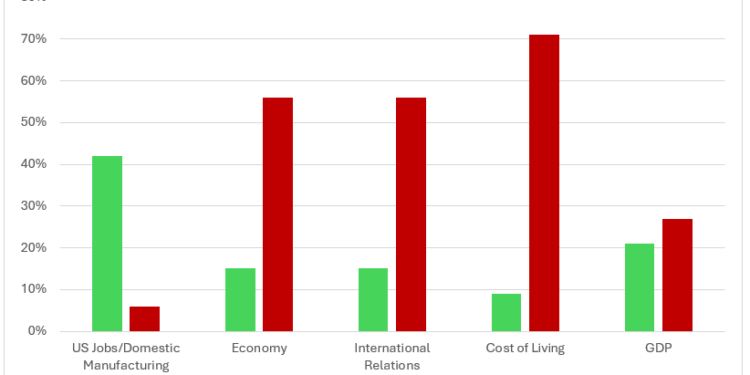On April 2 President Trump signed an executive order imposing a minimum 10% tariff on all U.S imports that went into effect on April 5.
The president coined this day “liberation day” and a white house fact sheet released on April 2nd claims the tariffs will improve the American Economy, address “global injustices”, and provide America with a “competitive edge”.
The president imposed a 10% tariff on all countries, citing that America had previously held some of the lowest tariff rates globally in comparison to key trading partners like Brazil (11.2%), China (7.5%), the European Union (5%), India (17%) and Vietnam (9.4%) according to fact sheet.
He is also imposing an individualized reciprocal higher tariff on the countries with which the US has the largest trade deficits, the largest of these tariffs being against China. The president excluded Mexico and Canada from these tariffs, with the two countries remaining under the existing fentanyl/migration IEEPA orders and USMCA compliancy tariffs.
Dr. Art Carden, an economics professor at Samford University’s Brock School of Business, finds the above claims made by the White House (and President Trump’s) to be inaccurate.
“Assume for the sake of the argument that the tariff numbers are accurate. Even if they are, the case for free trade is unilateral. The economist Joan Robinson captured the logic of reciprocal tariffs memorably: “It would be just as sensible to drop rocks into our harbors just because other nations have rocky coasts.”
Carden asserts that the US is already a manufacturing powerhouse, but it imports a large amount of manufactured goods because it is more efficient to use the resources necessary to produce those goods elsewhere.
“As I’ve said in my classes and in several other places, there are sophisticated arguments one can make for tariffs under very specific conditions. The problem is that Trump and his team aren’t making those arguments,” said Carden.
Carden also commented on the White House’s idea of gaining a competitive edge over other countries.
“The rhetoric of “competitive edge” is both ancient and wrong. The US isn’t “competing” with Canada, Mexico or China the way Walmart competes with Target, and in any case the global economy is not a zero-sum game. International trade enables us to enrich Canadians while Canadians enrich us.”
The US has introduced similar tariffs in the past. When asked about the success of these tariffs, Carden cited the 1828 Tariff of Abominations which contributed to the “Nullification Crisis, almost dissolved the union, and contributed to a recession in 1828-1829”. Another tariff, The Smoot-Hawley Tariff of 1930, helped turn a recession into the Great Depression.”
As for how these tariffs will affect the economy, Carden believes prices will increase while we will be poorer, and we will have less variety.
Carden advises young adults, like Samford University students, to consume less, recommit themselves to learning and be diligent to insulate themselves from economic shock.
Carden’s final piece of advice was to “recognize that the answer to “when am I ever gonna need to know this?” is “When someone comes along promising to Make America Great Again by cutting off trade with the rest of the world.” Look for other areas in your studies where this might apply.”
Samford students also hold concerns about Trump’s tariffs. In a recent anonymous poll conducted by the Samford Crimson, 58.8% of student respondents somewhat or strongly disagreed with President Trump’s tariff policies.
Of those students who disagreed with the new tariffs, 94% felt the cost of Living (described in the poll as housing, food, transportation, healthcare, and utilities) would be negatively impacted. Other areas of concern included the US economy and its relationship to other countries.
Of the 26.5 percent of students who somewhat or strongly agreed with President Trump’s tariffs, 45% expect to see improvement in the US economy, GDP (gross domestic product), and relationship to other countries.
41% of all student respondents expected to see an increase in US jobs due to domestic manufacturing.
One student felt that the tariffs will be valuable for the US in the long run, stating “I think that while it might have some negative immediate and developing effects on the US, it will ultimately provide better positive effects overtime. I think it shows that we have a leader who is not going to back down and is ready to lead the US into a better and stronger nation overall.”
Another student believes that the tariffs will slow US economic growth. “The US doesn’t have enough resources to produce everything it’s accustomed to using in mass in such a short amount of time; all of that requires permits, increase in production, and a myriad of other things that take a lot of time and patience to attain. It’s very likely that the implementation of these tariffs will cause inflation, job loss, and a huge widening in the gaps between social classes.”
Multiple students also mentioned concerns regarding the price of groceries and housing, and how the tariffs might affect their ability to support themselves as they enter the workforce.
President Trump has amended his initial 10% tariff rule and placed a 145% tariff on The People’s Republic of China. They have since retaliated with 125% tariff on all US goods.

Staff Reporter




